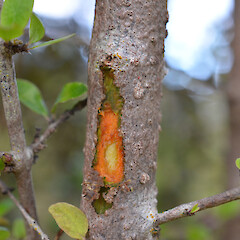Coprosma wallii
Synonyms
None
Family
Rubiaceae
Flora category
Vascular – Native
Endemic taxon
Yes
Endemic genus
No
Endemic family
No
Structural class
Trees & Shrubs - Dicotyledons
NVS code
The National Vegetation Survey (NVS) Databank is a physical archive and electronic databank containing records of over 94,000 vegetation survey plots - including data from over 19,000 permanent plots. NVS maintains a standard set of species code abbreviations that correspond to standard scientific plant names from the Ngä Tipu o Aotearoa - New Zealand Plants database.
COPWAL
Chromosome number
2n = 132
Current conservation status
The conservation status of all known New Zealand vascular plant taxa at the rank of species and below were reassessed in 2017 using the New Zealand Threat Classification System (NZTCS) – more information about this can be found on the NZTCS website. This report includes a statistical summary and brief notes on changes since 2012 and replaces all previous NZTCS lists for vascular plants.
Please note, threat classifications are often suggested by authors when publications fall between NZTCS assessment periods – an interim threat classification status has not been assessed by the NZTCS panel.
- Conservation status of New Zealand indigenous vascular plants, 2017 . 2018. Peter J. de Lange, Jeremy R. Rolfe, John W. Barkla, Shannel P. Courtney, Paul D. Champion, Leon R. Perrie, Sarah M. Beadel, Kerry A. Ford, Ilse Breitwieser, Ines Schönberger, Rowan Hindmarsh-Walls, Peter B. Heenan and Kate Ladley. Department of Conservation. Source: NZTCS and licensed by DOC for reuse under the Creative Commons Attribution 4.0 International licence.
2017 | At Risk – Declining | Qualifiers: CD, RF
Previous conservation statuses
2012 | At Risk – Declining | Qualifiers: CD, RF
2009 | At Risk – Declining | Qualifiers: CD, RF
2004 | Gradual Decline
Brief description
Bushy dark green shrub or small tree with orange under-bark and many very wide-angled branches bearing groups of pairs of small oval leaves and bulging dark violet to black strongly twinned (didymous) fruit. Leaves 5–10mm long, nearly as wide as long, with a triangular hairy ridge on the fuzzy stem between leaf bases. Seeds nearly round.
Distribution
Endemic. North Island, South Island and Stewart Island/Rakiura. In the North Island, rather local and with a predominantly eastern distribution from the Ripia River Headwaters to Wairarapa, with only two western populations at Erua and Paengaroa. In in the South Island much more widespread in both the east and west (with new populations still being discovered mainly in the west and south). On Stewart Island/Rakiura, discovered in 2000 and still known from only one location.
Habitat
Occupies a range of habitats from seasonally flooded, alluvial forest prone to very cold winters and dry summers, to riparian forest and subalpine scrub, or as a component of grey scrub or mixed Podocarp forest developed on steeply sloping basaltic or andesitic rock. The key feature of the majority of C. wallii habitat is that the substrates are rather fertile and the vegetation is limited by frost, water logging, or severe summer drought. Never associated with broad-leaved canopy trees.
Detailed description
Shrub to small tree (1.8)–2–(3) m. Trunk stout, clad in dark bubbly bark, under bark dark red. Branches stout, erect then spreading, somewhat pagodiform, branchlets stout, subtetragonous, densely clad in short, appressed, antrorse ruffous hairs. Petioles pubescent, c.1 mm. Seedling and juvenile leaves rhomboid to ovate-oblong, densely clad in long, dark, rufous appressed hairs. Adult leaves leathery, glabrous, 5–9 × 5–7 mm, broad-ovate to suborbicular, broadly ovate-oblong, obtuse, subtruncate at base, dark green to green, upper surface very shiny, veins not evident, under sides paler, midrib and secondary veins evident. Flowers 1–(2–3) on short branchlets; male without calyx, corolla short, broadly campanulate, lobes broad-ovate, acute; female corolla funnelform, lobes triangular, acute, Drupe ovoid, didymous, 3 × 4.5 mm, dark violet black to black.
Manaaki Whenua Online Interactive Key
Similar taxa
Easily recognised through a combination of its tall shrub to small tree habit, dark red under bark, leafy branches bearing numerous rather dark green, shiny, small leaves, and by the dark violet-black strongly twinned (didymous) fruits.
Flowering
No information
Fruiting
Fruit may be present throughout the year. However, they are most conspicuous between March and May
Life cycle
Fleshy drupes are dispersed by frugivory (Thorsen et al., 2009).
Propagation technique
Easy from fresh seed. Can be grown from semi-hardwood cuttings. Quite fast growing, doing best in fertile, moist alluvial soils but once established remarkably tolerant of a wide variety of soils and moisture regimes.
Threats
Although not as threatened as once believed, several North and South Island populations are in vulnerable habitats or persist as remnant stands within rough pasture and/or along roadsides. In these sites recruitment is limiting or absent. Weeds remain a long term threat at virtually all known habitats. As a somewhat cryptic plant it is also vulnerable through the failure to recognise it. Some populations on track sides and near popular scenic attractions have been damaged by track maintence, and in one site the erection of a toilet block.
Etymology
coprosma: From the Greek kopros ‘dung’ and osme ‘smell’, referring to the foul smell of the species, literally ‘dung smell’
Where To Buy
Not commercially available.
Attribution
Fact Sheet prepared for NZPCN by P.J. de Lange 1 August 2003. Description based on Allan (1961).
References and further reading
Allan HH. 1961. Flora of New Zealand, Volume I. Indigenous Tracheophyta: Psilopsida, Lycopsida, Filicopsida, Gymnospermae, Dicotyledones. Government Printer, Wellington, NZ. 1085 p.
Thorsen MJ, Dickinson KJM, Seddon PJ. 2009. Seed dispersal systems in the New Zealand flora. Perspectives in Plant Ecology, Evolution and Systematics 11: 285–309.
NZPCN Fact Sheet citation
Please cite as: de Lange, P.J. (Year at time of access): Coprosma wallii Fact Sheet (content continuously updated). New Zealand Plant Conservation Network. https://www.nzpcn.org.nz/flora/species/coprosma-wallii/ (Date website was queried)

























